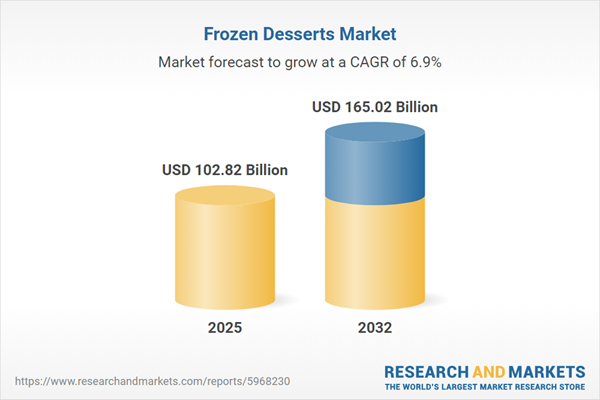Speak directly to the analyst to clarify any post sales queries you may have.
The frozen desserts market has entered a new phase of evolution, shaped by rapid product innovation, shifting consumer preferences, and emerging supply chain strategies. Companies active in this sector are assessing both opportunities and risks as they compete to address a diversifying global customer base while responding to regulatory and operational change.
Market Snapshot: Frozen Desserts Market Size and Growth
The frozen desserts market grew from USD 96.54 billion in 2024 to USD 102.82 billion in 2025. With a projected CAGR of 6.93%, the market is on track to reach USD 165.02 billion by 2032. Growth is propelled by a combination of consumer demand for healthy, plant-based, and functional treats, as well as strong performance across developed and emerging regions.
Scope & Segmentation
- Product Types: Ice cream, gelato, frozen yogurt, sherbet, sorbet, frozen cakes, pastries, frozen novelties including ice cream sandwiches and ice pops, and both low-fat/no-fat and regular varieties.
- Source Materials: Dairy-based options; non-dairy (plant-based) alternatives such as almond milk, coconut milk, oat milk, and soy milk.
- Dietary Preferences: Allergen-free, gluten-free, keto-friendly, sugar-free, and other specialty dietary options.
- Packaging Formats: Bars, sticks, cones, cups, tubs—suited to both impulse purchases and planned consumption.
- Distribution Channels: Offline channels including convenience stores, hypermarkets, supermarkets, and specialty shops; online sales via brand websites, e-commerce platforms, and subscription services.
- Geographic Coverage: Americas (United States, Canada, Mexico, Brazil, Argentina, Chile, Colombia, Peru), Europe (United Kingdom, Germany, France, Russia, Italy, Spain, Netherlands, Sweden, Poland, Switzerland), Middle East (UAE, Saudi Arabia, Qatar, Turkey, Israel), Africa (South Africa, Nigeria, Egypt, Kenya), and Asia-Pacific (China, India, Japan, Australia, South Korea, Indonesia, Thailand, Malaysia, Singapore, Taiwan).
- Leading Companies: Featuring brands such as Unilever PLC, Nestlé S.A., General Mills, Inc., Yili Group, Danone S.A., Conagra Brands, and more, including regional and boutique manufacturers and ingredient suppliers.
- Enabling Technologies: Cryogenic freezing, advanced packaging, cold chain logistics, and digital sales channels supporting market transformation.
Key Takeaways for Senior Decision-Makers
- Product portfolios are expanding rapidly to include both traditional and plant-based desserts, allowing brands to reach new audience segments and dietary niches.
- Innovation in packaging and distribution is facilitating growth in both impulse and planned consumption, supported by the rise of e-commerce and subscription models.
- Health and wellness trends continue to shift market dynamics, with functional, reduced sugar, and allergen-free categories gaining ground across regions.
- Investment in cold chain logistics and supply chain resilience is enabling manufacturers to maintain product quality while expanding into new geographies.
- Regional differences in flavor preferences, ingredient sourcing, and branding approaches require tailored market-entry and product development strategies.
- Industry leaders combine broad distribution networks with agile R&D to respond quickly to local demand, regulatory changes, and evolving consumer expectations.
Tariff Impact: Preparing for Regulatory Change
Senior figures should anticipate that proposed United States tariffs in 2025 could raise costs for imported ingredients and packaging. These measures will likely prompt strategic shifts toward regional suppliers, revised contract terms, and innovation in sourcing. Producers may need to weigh the complexities of local versus global supply chains and invest in scenario planning to manage cost impacts efficiently.
Methodology & Data Sources
This report integrates secondary research from industry publications, regulatory filings, and proprietary databases with primary research including expert executive and supply chain interviews. Field observations and data triangulation validate operational capabilities, ensuring both a broad and granular perspective on market behavior.
Frozen Desserts Market: Why This Report Matters
- Enables data-driven decision-making by providing actionable insights for optimizing product portfolios, go-to-market planning, and response to regulatory risks.
- Equips executives to benchmark against innovation leaders, anticipate technological disruptions, and tailor regional growth strategies with confidence.
Conclusion
In an environment of shifting consumer demands and evolving trade landscapes, timely intelligence on the frozen desserts market is essential. This report empowers leaders to capture new opportunities and mitigate risk with strategic clarity.
Additional Product Information:
- Purchase of this report includes 1 year online access with quarterly updates.
- This report can be updated on request. Please contact our Customer Experience team using the Ask a Question widget on our website.
Table of Contents
3. Executive Summary
4. Market Overview
7. Cumulative Impact of Artificial Intelligence 2025
Companies Mentioned
The companies profiled in this Frozen Desserts market report include:- Am. D.Q. Corp.
- Archer-Daniels-Midland Company
- Arla Foods Group
- Barentz International B.V.
- Blue Bell Creameries
- Conagra Brands, Inc.
- Dairy Farmers of America Inc.
- Daiya Foods Inc. by Otsuka Pharmaceutical Co., Ltd.
- Danone S.A.
- Ferrero International S.A.
- Fonterra Co-operative Group Limited
- Froneri International Limited
- General Mills, Inc.
- Gujarat Co-operative Milk Marketing Federation Limited
- Inspire Brands LLC
- Kellanova
- Meiji Holdings Company, Ltd.
- Mondelez International, Inc.
- MTY Food Group Inc.
- Nestlé S.A.
- The Hain Celestial Group, Inc.
- Tofutti Brands Inc.
- Tyson Foods, Inc.
- Unilever PLC
- Yili Group
Table Information
| Report Attribute | Details |
|---|---|
| No. of Pages | 187 |
| Published | November 2025 |
| Forecast Period | 2025 - 2032 |
| Estimated Market Value ( USD | $ 102.82 Billion |
| Forecasted Market Value ( USD | $ 165.02 Billion |
| Compound Annual Growth Rate | 6.9% |
| Regions Covered | Global |
| No. of Companies Mentioned | 26 |









